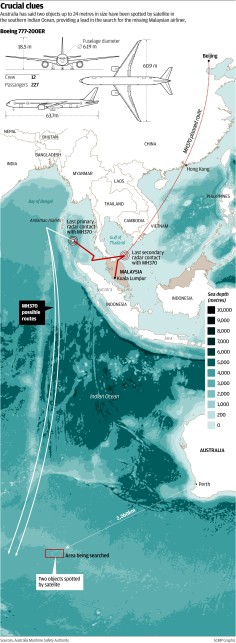
Recovery of flight 370 wreckage in Indian Ocean would be 'no easy job'
Depth of Indian Ocean means any retrieval of wreckage would be 'very challenging'

Finding the main wreckage and black boxes of the missing Malaysia Airlines flight MH370 would require Herculean efforts, state-of-the-art technology and no small amount of luck.
Two large objects were spotted floating in a remote part of the Indian Ocean yesterday, raising hopes that the mystery of the missing Boeing 777 could finally be solved.
But experts quickly cautioned the public about expectations. Even if investigators confirmed that the two objects were from the missing jet, it would take a while to salvage the wreckage and the black boxes - or flight-data recorders - that would most likely have plunged to the ocean floor.

Hishammuddin Hussein, Malaysia's acting transport minister, acknowledged the size of the task at a press conference in Kuala Lumpur, comparing the search to the extended hunt for Air France flight 477 in 2009 that took nearly two years.
"The conditions in the Indian Ocean are very similar to that of the Atlantic Ocean. It will be very challenging," Hishammuddin said.
Chinese experts agreed with his assessment.
Professor Dong Chaoyang , an aeronautics scientist at the Beijing University of Aeronautics and Astronautics, compared the task ahead to the hunt for flight 477, the wreckage of which was found some 3,000 metres below the surface. Many of the bodies were never found.
"The depth of 3,000 metres is way beyond the reach of the bravest divers," he said.
"Such hazardous depths will considerably delay the solving of this mystery."
Even the most advanced US nuclear submarine would struggle to operate below 500 metres.
To conduct operations at such depths, the search teams would have to face steel-crushing water pressure, a complete absence of light and extremely low temperatures.
"Even if they found and confirmed the exact location of the wreckage, to reach the black box and bring it up would be a daunting task," Dong said.
"It took more than two years to retrieve the black box of the Air France plane. It could take longer this time."
Once a search area was confirmed, the salvage teams would have to send submarines equipped with advanced sonar systems to pinpoint the precise location of the main area of wreckage.
In the Air France case, France dispatched its nuclear submarine and two ships equipped with towed sonar sensors to search the area once the crash site was found.
It still took the French months to pinpoint the location.
After that, submersible robots salvaged the wreckage. Only a few nations can build and operate such machines.
An oceanographer with the Ocean University of China in Qingdao, who asked not to be identified, said Chinese ships had high-resolution sonar equipment that could penetrate thousands of metres under the water.
"The black boxes are very important to China, we will be forever left in the dark on some serious questions if they are lost, or found by other countries [who may not want to share the data]," he said.
He said China's deep-sea research submersible, the Jiaolong, could reach beyond 7,000 meters with a three-person crew.
But he added that the craft would need to undergo significant modifications for a retrieval mission.